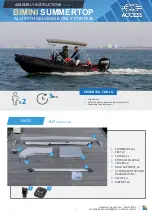
settings for step 1 and 4. Step 2 and 3 are always definite
time delayed.
All IEC and ANSI inverse time characteristics are available.
The directional function is voltage polarized with memory.
The function can be set to be directional or non-
directional independently for each of the steps.
Four step residual overcurrent protection EF4PTOC
(51N_67N)
M13667-3 v11
The four step residual overcurrent protection (EF4PTOC,
51N/67N) has independent inverse time delay settings for
step 1 and 4. Step 2 and 3 are always definite time
delayed.
All IEC and ANSI inverse time characteristics are available.
The directional function includes 3 options
• voltage polarized
• current polarized
• dual polarized
EF4PTOC (51N/67N) can be set directional or non-
directional independently for each of the steps.
Second harmonic blocking can be set individually for each
step.
Thermal overload protection, two time constant
TRPTTR (49)
M13243-3 v7
If a power transformer or generator reaches very high
temperatures the equipment might be damaged. The
insulation within the transformer/generator will have
forced ageing. As a consequence of this the risk of
internal phase-to-phase or phase-to-ground faults will
increase. High temperature will degrade the quality of the
transformer/generator insulation.
The thermal overload protection estimates the internal
heat content of the transformer/generator (temperature)
continuously. This estimation is made by using a thermal
model of the transformer/generator with two time
constants, which is based on current measurement.
Two warning pickup levels are available. This enables
actions in the power system to be done before dangerous
temperatures are reached. If the temperature continues to
increase to the trip value, the protection initiates a trip of
the protected transformer/generator.
Breaker failure protection CCRBRF (50BF)
M11550-6 v9
Breaker failure protection (CCRBRF, 50BF) ensures fast
back-up tripping of surrounding breakers in case the
protected breaker fails to open. CCRBRF (50BF) can be
current based, contact based, or an adaptive combination
of these two conditions.
Current check with extremely short reset time is used as
check criterion to achieve high security against
unnecessary operation.
Contact check criteria can be used where the fault current
through the breaker is small.
Breaker failure protection (CCRBRF, 50BF) current criteria
can be fulfilled by one or two phase currents, or one phase
current plus residual current. When those currents exceed
the user defined settings, the function is activated. These
conditions increase the security of the back-up trip
command.
CCRBRF (50BF) function can be programmed to give a
three-phase re-trip of the protected breaker to avoid
unnecessary tripping of surrounding breakers.
Pole discordance protection CCRPLD (52PD)
M13269-3 v10
Circuit breakers and disconnectors can end up with their
phase poles in different positions (close-open), due to
electrical or mechanical failures.An open phase can cause
negative and zero sequence currents which cause thermal
stress on rotating machines and can cause unwanted
operation of zero sequence or negative sequence current
functions.
Normally the affected breaker is tripped to correct such a
situation. If the situation warrants the surrounding
breakers should be tripped to clear the unsymmetrical
load situation.
The pole discrepancy function operates based on
information from the circuit breaker logic with additional
criteria from unsymmetrical phase currents when
required.
Negative sequence based overcurrent function
DNSPTOC (46)
GUID-CFD34404-5934-41EE-8AAC-A5FD2B9B4E33 v3
Negative sequence based overcurrent function (DNSPTOC,
46) may be used in power line applications where the
reverse zero sequence source is weak or open, the forward
source impedance is strong and it is desired to detect
forward ground faults.
Additionally, it is applied in applications on underground
cables, where zero sequence impedance depends on the
fault current return paths, but the cable negative
sequence impedance is practically constant.
Busbar protection REB650
1MRK 505 265-BUS B
Version 1.1 ANSI
10
ABB Power Grids
© Copyright 2011 ABB Power Grids. All rights reserved











































